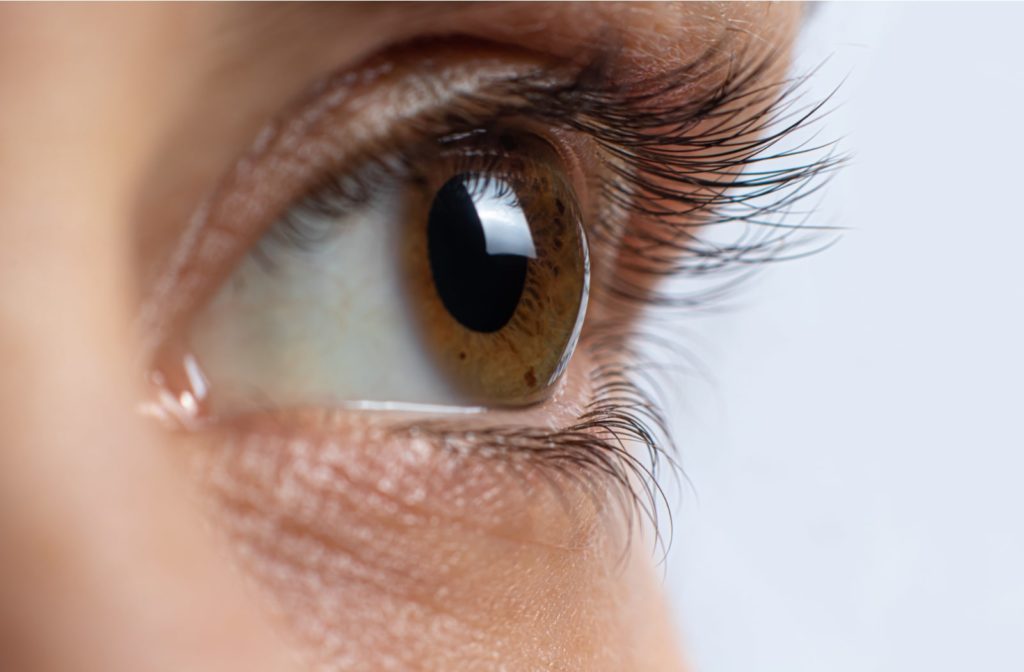If you’ve ever struggled with dry eyes, you know that the symptoms are often very uncomfortable. And if you have a severe case, the discomfort can be downright debilitating. If this is you, you’re not alone because approximately 30% of Canada’s population struggle with dry eye symptoms.
In some cases, circumstances may lead to your eyes being fine one day and severely irritated and dry the next. Other times, it’s an ongoing thing where the irritation and symptoms worsen over time.
Getting regular eye exams is one way of diagnosing dry eye before it bothers you. And if it’s caught early enough, the optometrist may be able to prevent or minimize future symptoms.
What is Dry Eye Disease?
The tears in our eyes are supposed to keep our eyes lubricated. We develop dry eye syndrome when they don’t do this or do an inadequate job. And unfortunately, this is a widespread condition. Sometimes, it’s situational, but other times there’s something more going on.
Dry Eye Causes
There are several primary causes of dry eyes. The root cause typically affects how the optometrist treats them.
Inadequate Tear Production
One of the main causes of dry eyes is when our eyes don’t produce enough tears. There could be a few different reasons for this:
- Age: As we get older, our eyes often don’t work as well as they should.
- Underlying Medical Conditions: Certain underlying conditions like rheumatoid arthritis, lupus, or thyroid disorders can affect your tear production. During a comprehensive eye exam, your optometrist should be able to determine if you have any underlying conditions that put you at risk for dry eyes.
- Medications: Many common over-the-counter (OTC) medications can also affect your tear production. Let your optometrist know what medications you are on, so they can determine if adjustments are needed.
- Other Factors: Several other factors like contact lens use or eye surgery can contribute to dry eyes. Often these only things cause short-term dry eye symptoms.
Excessive Tear Evaporation
Even if your eyes produce enough tears, you’ll experience dry eye symptoms if they evaporate too quickly. Here are several things that can contribute to excessive tear evaporation:
- Not blinking enough
- Abnormal eyelid function
- Allergies
- Sensitivity to preservatives in eye drops
- Posterior blepharitis
- Environmental things like smoke and dry air
Symptoms of Dry Eyes
Other than a common symptom like an itchy or scratchy feeling in your eyes, several symptoms bring discomfort with dry eyes:
- Light sensitivity
- Feeling like there’s something in your eyes
- Discomfort when wearing contact lenses
- Red eyes
- Mucus in or around the affected eye
- Blurry vision
- Watery eyes—this one may seem counterintuitive when the main reason for dry eyes is the lack of tears, but this is your eye’s way of overcompensating for eye irritation.
Dry Eye Home Remedies
Luckily, there are a few different ways to treat dry eye symptoms at home. It’s always a good idea to see an optometrist and confirm that there are no serious underlying causes for your dry eyes, though.
Cleaning Eyelids
Because posterior blepharitis is a common cause of dry eyes, sometimes regular eyelid cleaning can successfully treat and prevent dry eyes. The goal of cleaning your eyelids is to open the clogged oil glands to allow a proper flow.
One method for eyelid cleaning is to apply a wet, warm cloth over your eyes. Keep it on your eyelids for at least 5 minutes—rewarm it as needed. Once it’s sat on your eyes, gently rub your eyelids and eyelashes with it. This helps loosen any debris, which you can clean away.
After loosening everything with the warm cloth, apply a small amount of mild soap to your eyelids (or a mild cleanser like Cetaphil) and the base of your eyelashes. Massage your closed eyes gently, and then rinse thoroughly.
You can even purchase eyelid cleaners such as eyelid cleaning wipes to clean your eyelids at home.
OTC Options
There are a few nonprescription options available that you can try for mild or nonpersistent symptoms:
- Eyedrops: choose a preservative-free eyedrop if you need to use them several times a day.
- Gels
- Ointments: Ointments usually provide longer and more effective relief than eye drops or gels. However, they are also thicker and can cause your vision to be blurry. Most people find the evening before bed the best time to use them.
Medical Treatments for Dry Eyes
If home remedies are not working to treat your dry eyes, there are several treatments and therapies available that your optometrist can administer. In the case of underlying issues causing your dry eyes, the optometrist can often fix the root of the problem.
Closing Thoughts on Cleaning Eyelids to Treat Dry Eyes
Cleaning your eyelids is often a very successful treatment for dry eyes. But if you’ve tried it, and the OTC eye drops aren’t giving you the relief you need, give our office a call. We’re happy to book you in so that one of our optometrists can help relieve your eye discomfort as soon as possible.



